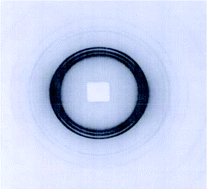Mesh phases in tetramethylammonium perfluorodecanoate–water ternary systems
Abstract
The evolution of the phase behaviour and lyotropic phase structures formed in the tetramethylammonium perfluorodecanoate (C10TMA)–water system upon the addition of a third component (![[3 with combining macron]](https://www.rsc.org/images/entities/char_0033_0304.gif) m space group. With increasing concentration of both additives, the Mh1(R
m space group. With increasing concentration of both additives, the Mh1(R![[3 with combining macron]](https://www.rsc.org/images/entities/char_0033_0304.gif) m) phase changes to a random mesh phase Mh1(0) via a two phase region. The structure of the Mh1(R
m) phase changes to a random mesh phase Mh1(0) via a two phase region. The structure of the Mh1(R![[3 with combining macron]](https://www.rsc.org/images/entities/char_0033_0304.gif) m) phase is essentially unaltered with addition of TMACl or C10ol until the phase change to Mh1(0). With higher additive concentration, the water fraction within a mesh layer of the Mh1(0) phase is decreased. It is proposed that the transition from the Mh1(0) to Mh1(R
m) phase is essentially unaltered with addition of TMACl or C10ol until the phase change to Mh1(0). With higher additive concentration, the water fraction within a mesh layer of the Mh1(0) phase is decreased. It is proposed that the transition from the Mh1(0) to Mh1(R![[3 with combining macron]](https://www.rsc.org/images/entities/char_0033_0304.gif) m) phases is driven by a reduction in the electrostatic interlayer interaction enabling non-electrostatic repulsive interactions to dominate. This is because of the strong association of the TMA counter ion with the head group region, the increase of
m) phases is driven by a reduction in the electrostatic interlayer interaction enabling non-electrostatic repulsive interactions to dominate. This is because of the strong association of the TMA counter ion with the head group region, the increase of ![[3 with combining macron]](https://www.rsc.org/images/entities/char_0033_0304.gif) m) phase. It is also shown that the hydrophobic counter ion has to be small relative to the
m) phase. It is also shown that the hydrophobic counter ion has to be small relative to the


 Please wait while we load your content...
Please wait while we load your content...